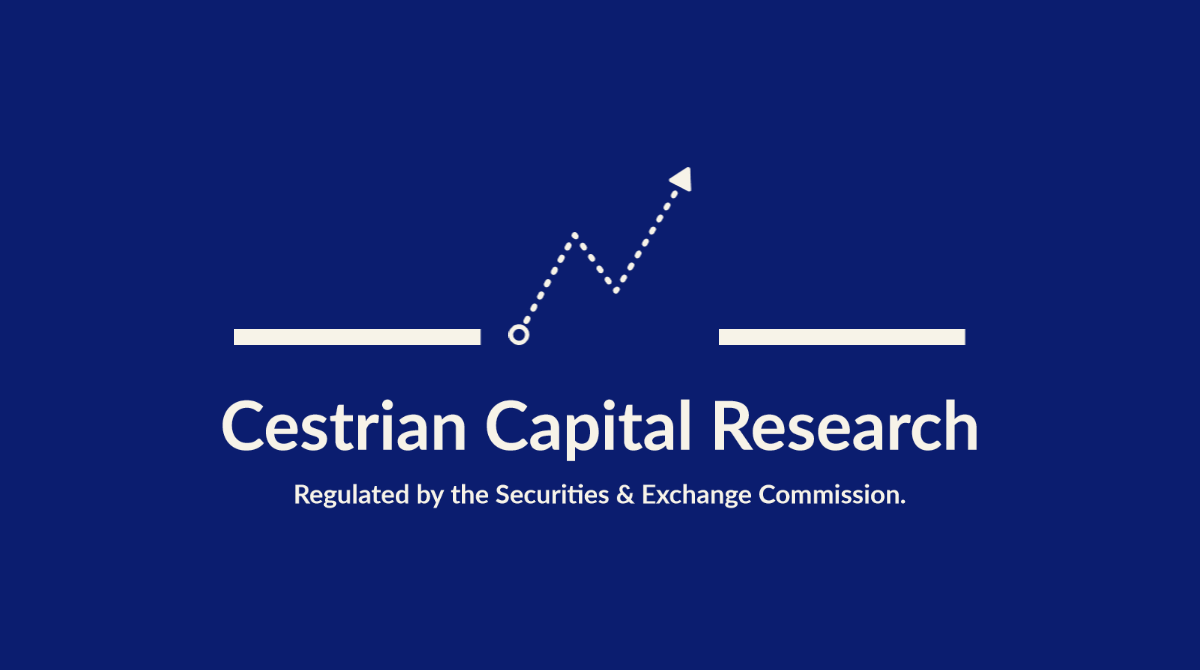Own A Piece Of History

DISCLAIMER: This note is intended for US recipients only and, in particular, is not directed at, nor intended to be relied upon by any UK recipients. Any information or analysis in this note is not an offer to sell or the solicitation of an offer to buy any securities. Nothing in this note is intended to be investment advice and nor should it be relied upon to make investment decisions. Cestrian Capital Research, Inc., its employees, agents or affiliates, including the author of this note, or related persons, may have a position in any stocks, security, or financial instrument referenced in this note. Any opinions, analyses, or probabilities expressed in this note are those of the author as of the note's date of publication and are subject to change without notice. Companies referenced in this note or their employees or affiliates may be customers of Cestrian Capital Research, Inc. Cestrian Capital Research, Inc. values both its independence and transparency and does not believe that this presents a material potential conflict of interest or impacts the content of its research or publications.
Own A Piece Of History: Central Securities Corporation ($CET)
An Inner Circle article by member 1markb44
You hear a lot in the online investment world about the newest, hottest thing; but what’s wrong with the older players out there? How about a REALLY old player? I ran across Central Securities Corporation ($CET) early this year in an article about creating a set-and-forget portfolio of CEF’s, or Closed End Funds. Unlike the better-known mutual funds CEF’s are like stocks in that they issue a set number of shares and trade the same way, throughout the day rather than setting their closing price at the market’s close like mutuals do.
A few CEF’s, including $CET, are true dinosaurs of the investment world, having started in the 1920’s. $CET’s inception was October 1, 1929, so it’s fast coming up on its 95th birthday: that’s a lot of candles! Think about that: a huge number of booms and busts to navigate though, not to mention late 1929 wasn’t exactly the most auspicious time to launch a fund.
So great, $CET is really old, well done, but how does it perform? Very well, actually. Morningstar reports that their 15 year total return is 13.57%, and “earliest available” (which I take to mean that $CET goes so far back M’star looked back as far as it felt like, but not the whole 95-year period) is 13.81%: solid, indeed! Or you can go to $CET’s own website and check the annual reports, most recently of course for 2023 (just the title page alone has max coolness, with its “95th Annual Report” title), and see the graph showing 10/20/30/40/50 year total returns (who else can do that?), with the 50 year total return at 14.4%...okay, I’m convinced!
What you see when you look under the hood is that $CET is the classic “Steady Eddie”: it buys stocks it believes in and holds them for periods that are almost never seen these days. In the current top ten list of holdings we find Analog Devices, held since 1987, and Amazon, held since 2014, among other long-timers. Annual turnover is almost nil, in the low single digits. Standard deviation, which measures how far the price will stray from the center, is a SWAN-like 13%. Beta, which tracks how wildly the price will swing on a daily basis, is ridiculously low for a stock fund at .70, meaning CEF moves only 70% of the average market change.
You see the steadiness demonstrated in the upside and downside capture ratios. Per Morningstar CET’s 10-year upside capture was 83%, compared to the base market 100%; but the downside capture was a very low 73%, compared to 100%, meaning they lagged in bull periods but more than made it up in bearish ones. On the “risk/return” graph Morningstar has $CET at the elusive and desirable “lowest risk/highest return”. All this for a very reasonable expense ratio of .56%.
One interesting part of $CET’s portfolio is that its largest holding, at 24%, is a private insurance company, Plymouth Rock, which operates in New England and is owned by a former state insurance commissioner. They’ve held Plymouth Rock since 1982. Sound like any other mutual fund-like company that has held an insurance company since forever?
A good part of $CET’s total return is their dividends. Unlike some CEF’s that pay monthly $CET does a small dividend in early summer and a large year-end one. Last year they paid .20 in June and 1.65 in November. This year they repeated the .20 in June and will do the second distribution later in the year.
I started a position in $CET in January and added to it a few times through April. My personal return YTD is 17.65% on a 21% total return YTD, not bad for a holding that mostly chugs along and doesn’t cause me any grief. When you consider the year-end large dividend the total return for the year should be very nice indeed.
In my mind’s eye I see the $CET folks working in a very clubby room with leather chairs, with a ticker tape machine spitting out paper, just like in 1929. As always do your own due diligence in researching an investment, but $CET may be well worth your money, if nothing else than for the story!
1markb44 for Cestrian Capital Research, Inc - 20 September 2024.
